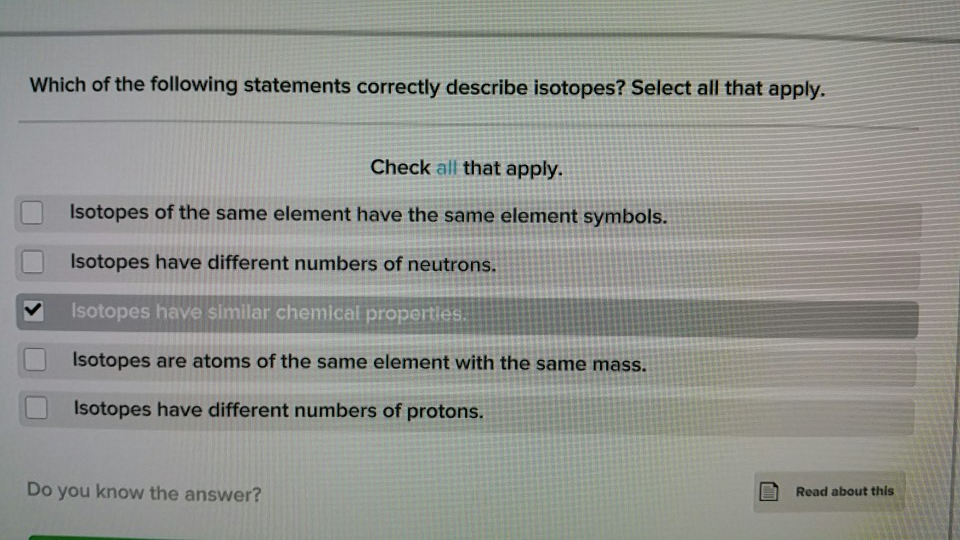2.4 Nuclei of Atoms
- Atoms Of The Same Element With Different Numbers Of Neutrons Are Defined As
- Atoms Of The Same Element With Different Numbers Of Neutrons
- Atoms Of The Same Element With Different Numbers Of Neutrons Are
- Atoms Of The Same Element With Different Numbers Of Neutrons Are Called What
- Atoms Of The Same Element That Have Different Numbers Of Neutrons Are Classified As
- How To Find Atoms Of An Element

Learning Objectives
The number of protons determine the chemical properties of an atom. The number of protons then determine which element the atom is. The number of neutrons have no effect on the chemical properties but do affect the nuclear properties. Some ratios of protons to neutrons are more stable than other ratios. The number of neutrons can be different, even in atoms of the same element. Atoms of the same element that contain the same number of protons, but different numbers of neutrons, are known as isotopes. Isotopes of any given element all contain the same number of protons, so they have the same atomic number (for example, the atomic number of. Although all atoms of an element have the same number of protons, they may not all have the same number of neutrons. Atoms of a single element that possess different numbers of neutrons are called of that element. An isotope is an atom of the same chemical element that has the same number of protons in its nucleus, but not the same number of neutrons. Therefore, this isotope atom will have the same atomic number and will be located in the same place of the periodic table of.
- Define and differentiate between the atomic number and the mass number of an element.
- Explain how isotopes differ from one another.
Now that we know how atoms are generally constructed, what do atoms of any particular element look like? How many protons, neutrons, and electrons are in a specific kind of atom?
First, if an atom is electrically neutral overall, then the number of protons equals the number of electrons. Because these particles have the same but opposite charges, equal numbers cancel out, producing a neutral atom.
Atomic Number
Atoms Of The Same Element With Different Numbers Of Neutrons Are Defined As
In the 1910s, experiments with X rays led to this useful conclusion: the magnitude of the positive charge in the nucleus of every atom of a particular element is the same. In other words, all atoms of the same element have the same number of protons. Furthermore, different elements have a different number of protons in their nuclei, so the number of protons in the nucleus of an atom is characteristic of a particular element. This discovery was so important to our understanding of atoms that the number of protons in the nucleus of an atom is called the atomic numberThe number of protons in the nucleus of an atom..

For example, hydrogen has the atomic number 1; all hydrogen atoms have 1 proton in their nuclei. Helium has the atomic number 2; all helium atoms have 2 protons in their nuclei. There is no such thing as a hydrogen atom with 2 protons in its nucleus; a nucleus with 2 protons would be a helium atom. The atomic number defines an element. Chapter 21 'Appendix: Periodic Table of the Elements' lists the elements and their atomic numbers. From this table, you can determine the number of protons in the nucleus of any element. The largest atoms have over 100 protons in their nuclei.
Example 3
What is the number of protons in the nucleus of each element? (Use the table in Chapter 21 'Appendix: Periodic Table of the Elements'.)

- aluminum
- iron
- carbon
Solution
- According to the table, aluminum has an atomic number of 13. Therefore, every aluminum atom has 13 protons in its nucleus.
- Iron has an atomic number of 26. Therefore, every iron atom has 26 protons in its nucleus.
- Carbon has an atomic number of 6. Therefore, every carbon atom has 6 protons in its nucleus.
Skill-Building Exercise
oxygen
What is the number of protons in the nucleus of each element? (Use the table in Chapter 21 'Appendix: Periodic Table of the Elements'.)
Atoms Of The Same Element With Different Numbers Of Neutrons
How many electrons are in an atom? Previously we said that for an electrically neutral atom, the number of electrons equals the number of protons, so the total opposite charges cancel. Thus, the atomic number of an element also gives the number of electrons in an atom of that element. (Later we will find that some elements may gain or lose electrons from their atoms, so those atoms will no longer be electrically neutral. Thus we will need a way to differentiate the number of electrons for those elements.)
Example 4
How many electrons are present in the atoms of each element?
- sulfur
- tungsten
- argon
Solution
- The atomic number of sulfur is 16. Therefore, in a neutral atom of sulfur, there are 16 electrons.
- The atomic number of tungsten is 74. Therefore, in a neutral atom of tungsten, there are 74 electrons.
- The atomic number of argon is 18. Therefore, in a neutral atom of argon, there are 18 electrons.
Skill-Building Exercise
potassium
How many electrons are present in the atoms of each element?
Isotopes
How many neutrons are in atoms of a particular element? At first it was thought that the number of neutrons in a nucleus was also characteristic of an element. However, it was found that atoms of the same element can have different numbers of neutrons. Atoms of the same element that have different numbers of neutrons are called isotopesAtoms of the same element that have different numbers of neutrons.. For example, 99% of the carbon atoms on Earth have 6 neutrons and 6 protons in their nuclei; about 1% of the carbon atoms have 7 neutrons in their nuclei. Naturally occurring carbon on Earth, therefore, is actually a mixture of isotopes, albeit a mixture that is 99% carbon with 6 neutrons in each nucleus.
An important series of isotopes is found with hydrogen atoms. Most hydrogen atoms have a nucleus with only a single proton. About 1 in 10,000 hydrogen nuclei, however, also has a neutron; this particular isotope is called deuterium. An extremely rare hydrogen isotope, tritium, has 1 proton and 2 neutrons in its nucleus. Figure 2.6 'Isotopes of Hydrogen' compares the three isotopes of hydrogen.

Figure 2.6 Isotopes of Hydrogen
Most hydrogen atoms have only a proton in the nucleus (a). A small amount of hydrogen exists as the isotope deuterium, which has one proton and one neutron in its nucleus (b). A tiny amount of the hydrogen isotope tritium, with one proton and two neutrons in its nucleus, also exists on Earth (c). The nuclei and electrons are proportionately much smaller than depicted here.
Atoms Of The Same Element With Different Numbers Of Neutrons Are
Note
The discovery of isotopes required a minor change in Dalton’s atomic theory. Dalton thought that all atoms of the same element were exactly the same.
Most elements exist as mixtures of isotopes. In fact, there are currently over 3,500 isotopes known for all the elements. When scientists discuss individual isotopes, they need an efficient way to specify the number of neutrons in any particular nucleus. The mass numberThe sum of the numbers of protons and neutrons in a nucleus of an atom. of an atom is the sum of the numbers of protons and neutrons in the nucleus. Given the mass number for a nucleus (and knowing the atomic number of that particular atom), you can determine the number of neutrons by subtracting the atomic number from the mass number.
A simple way of indicating the mass number of a particular isotope is to list it as a superscript on the left side of an element’s symbol. Atomic numbers are often listed as a subscript on the left side of an element’s symbol. Thus, we might see
which indicates a particular isotope of iron. The 26 is the atomic number (which is the same for all iron atoms), while the 56 is the mass number of the isotope. To determine the number of neutrons in this isotope, we subtract 26 from 56: 56 − 26 = 30, so there are 30 neutrons in this atom.
Example 5
How many protons and neutrons are in each atom?

Solution
- In there are 17 protons, and 35 − 17 = 18 neutrons in each nucleus.
- In there are 53 protons, and 127 − 53 = 74 neutrons in each nucleus.
Skill-Building Exercise
Atoms Of The Same Element With Different Numbers Of Neutrons Are Called What
How many protons and neutrons are in each atom?
It is not absolutely necessary to indicate the atomic number as a subscript because each element has its own unique atomic number. Many isotopes are indicated with a superscript only, such as 13C or 235U. You may also see isotopes represented in print as, for example, carbon-13 or uranium-235.
Concept Review Exercises
Atoms Of The Same Element That Have Different Numbers Of Neutrons Are Classified As
Why is the atomic number so important to the identity of an atom?
What is the relationship between the number of protons and the number of electrons in an atom?
How do isotopes of an element differ from each other?
Answers
The atomic number defines the identity of an element.
In an electrically neutral atom, the number of protons equals the number of electrons.
Isotopes have different numbers of neutrons in their nuclei.
The mass number is the sum of the numbers of protons and neutrons in the nucleus of an atom.
Key Takeaways
How To Find Atoms Of An Element
- Elements can be identified by their atomic number and mass number.
- Isotopes are atoms of the same element that have different masses.
Exercises
How many protons are in the nucleus of each element?
- radon
- tungsten
- chromium
- beryllium
How many protons are in the nucleus of each element?
- sulfur
- uranium
- calcium
- lithium
What are the atomic numbers of the elements in Exercise 1?
What are the atomic numbers of the elements in Exercise 2?
How many electrons are in neutral atoms of the elements in Exercise 1?
How many electrons are in neutral atoms of the elements in Exercise 2?
Complete the following table.
Number of Protons Number of Neutrons Element Name Isotope Symbol 80 120 2 hydrogen Complete the following table.
Number of Protons Number of Neutrons Element Name Isotope Symbol 95 153 21 potassium State the number of protons, neutrons, and electrons in neutral atoms of each isotope.
- 131I
- 40K
- 201Hg
- 19F
State the number of protons, neutrons, and electrons in neutral atoms of each isotope.
- 3H
- 133Cs
- 56Fe
- 207Pb
What is the mass number of a gallium atom that has 38 neutrons in it?
What is the mass number of a uranium atom that has 143 neutrons in it?
Complete each sentence.
- 48Ti has _____ neutrons.
- 40Ar has _____ neutrons.
- 3H has _____ neutrons.
Complete each sentence.
- 18O has _____ neutrons.
- 60Ni has _____ neutrons.
- 127I has _____ neutrons.
Answers
Number of Protons Number of Neutrons Element Name Isotope Symbol 80 120 mercury 26 29 iron 1 2 hydrogen - protons: 53; neutrons: 78; electrons: 53
- protons: 19; neutrons: 21; electrons: 19
- protons: 80; neutrons: 121; electrons: 80
- protons: 9; neutrons: 10; electrons: 9
69
- 26
- 22
- 2
